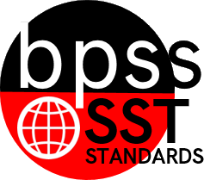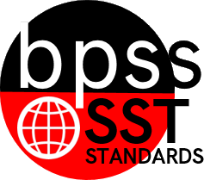5th Grade Social Studies (Archived)
 BPS District Social Studies Standards Book
BPS District Social Studies Standards Book
SST-05 "I can ... statements"
1st Grade Social Studies
2nd Grade Social Studies
4th Grade Social Studies
5th Grade Social Studies
7th Grade Social Studies
8th Grade Social Studies
| All categories |
PRIORITIZED BENCHMARKS |
|---|
SST-05.3.04
Student Learning Targets:Knowledge Targets
Reasoning Targets
Proficiency Rubric
ResourcesWebsites Helping Your Child With Social Studies
Vocabulary
| ||||||||||||||||||||||||||||||||||||||||
SST-05.4
Narrative for the Government and CitizenshipStudents in Grade 5 study the United States, focusing on the influence of physical and cultural characteristics on national origins, growth, and development up to 1800 through a formal exploration of United States history, geography, economics, government, current events, and cultural heritage. Students identify main components and characteristics of the United States government. They identify and explain key ideas in government from the colonial and founding periods that continue to shape civic and political life. Calculation Method for StandardsStandards are larger groups of related benchmarks. The Standard Grade is a calculation of all the related benchmarks. Click on the benchmark name below each Standard to access the learning targets and proficiency rubrics for each standard's related benchmarks. | |
SST-05.4.01
Student Learning Targets:Knowledge Targets
Reasoning Targets
Skills (Performance) Targets
Proficiency Rubric
ResourcesWebsites Helping Your Child With Social Studies
Vocabulary
| ||||||||||||||||||||||||||||||||||||||||
SST-05.4.02
Student Learning Targets:Knowledge Targets
Reasoning Targets
Skills (Performance) Targets
Product Targets
Proficiency Rubric
ResourcesWebsites Helping Your Child With Social Studies
Vocabulary
| ||||||||||||||||||||||||||||||||||||||||
SST-05.5
Narrative for the Concepts of GeographyStudents in Grade 5 study the United States, focusing on the influence of physical and cultural characteristics on national origins, growth, and development up to 1800 through a formal exploration of United States history, geography, economics, government, current events, and cultural heritage. Emphasis should be placed upon study of Native American Indian cultures, European exploration, colonization, settlement, revolution against British rule, the founding of the Republic and the beginnings of the United States. Students also learn to describe the major components of our national government and to demonstrate responsible citizenship in the classroom and school setting. Students describe the influence of the Earth/sun relationship on climate and use global grid systems; identify regions; describe physical and cultural characteristics; and locate states, capitals and major physical features of the United States. They also explain the changing interaction of people with their environment in regions of the United States and show how the United States is related geographically to the rest of the world. Calculation Method for StandardsStandards are larger groups of related benchmarks. The Standard Grade is a calculation of all the related benchmarks. Click on the benchmark name below each Standard to access the learning targets and proficiency rubrics for each standard's related benchmarks. | |
SST-05.6
Students in Grade 5 study the United States, focusing on the influence of physical and cultural characteristics on national origins, growth, and development up to 1800 through a formal exploration of United States history, geography, economics, government, current events, and cultural heritage. Emphasis should be placed upon study of Native American Indian cultures, European exploration, colonization, settlement, revolution against British rule, the founding of the Republic and the beginnings of the United States. Students also learn to describe the major components of our national government and to demonstrate responsible citizenship in the classroom and school setting. Calculation Method for StandardsStandards are larger groups of related benchmarks. The Standard Grade is a calculation of all the related benchmarks. Click on the benchmark name below each Standard to access the learning targets and proficiency rubrics for each standard's related benchmarks. | |
SST-05.6.01
Student Learning Targets:Knowledge Targets
Reasoning Targets
Skills (Performance) Targets
Product Targets
Proficiency Rubric
ResourcesWebsites Helping Your Child With Social Studies
Vocabulary
| ||||||||||||||||||||||||||||||||||||||||
STANDARD 1: SKILLS AND RESOURCES |
|---|
SST-05.1
Narrative for the Skills and ResourcesStudents in Grade 5 study the United States, focusing on the influence of physical and cultural characteristics on national origins, growth, and development up to 1800 through a formal exploration of United States history, geography, economics, government, current events, and cultural heritage. Emphasis should be placed upon study of Native American Indian cultures, European exploration, colonization, settlement, revolution against British rule, the founding of the Republic and the beginnings of the United States. Students also learn to describe the major components of our national government and to demonstrate responsible citizenship in the classroom and school setting. Through active learning experiences at the fifth grade level, students’ increasing interest in the ability to gather and organize data enables them to explore the physical and cultural characteristics of the United States and its neighbors. Most fifth grade students benefit from working and sharing in flexible groups so that they can become actively involved in “how-to” demonstrations. Their natural interest in science, biography, and travel set the stage for experience involving maps, memorabilia, collections, simulations, educational games, group-planned projects, first-person presentations, and school and community experiences. In activities, emphasis is placed on the problem-solving skills of questioning, examining fact and opinion, analyzing and evaluating sources of information, contrasting and comparing using primary and secondary sources, and conducting research using a variety of resources, including technology and electronic and print media. Additional skills to be taught include: (1) analyzing maps, globes, and graphic organizers; (2) creating and interpreting charts and graphs; (3) Identifying relationships; (4) debating issues; (5) posing alternative actions; and (6) developing thinking and independent study skills. Calculation Method for StandardsStandards are larger groups of related benchmarks. The Standard Grade is a calculation of all the related benchmarks. Click on the benchmark name below each Standard to access the learning targets and proficiency rubrics for each standard's related benchmarks. | |
SST-05.1.01
Student Learning Targets:Knowledge Targets
Reasoning Targets
Skills (Performance) Targets
Product Targets
Proficiency Rubric
ResourcesWebsites Helping Your Child With Social Studies
Vocabulary
| ||||||||||||||||||||||||||||||||||||||||


 Standard 3:
Standard 3: